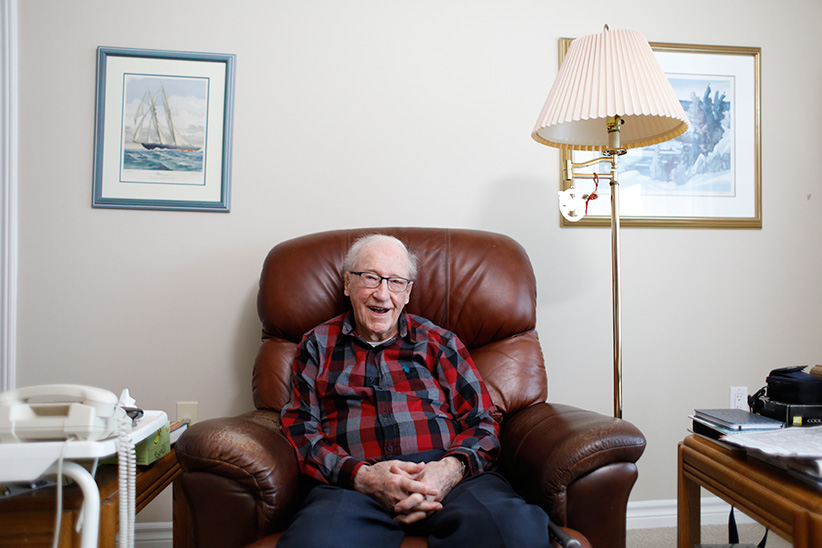The Canadian who has been dodging death for 100 years
Douglas Snair—who narrowly avoided the Halifax Explosion, a train wreck, a ship sinking and more, over the course of a century—may be Canada’s luckiest man
Douglas Snair, 100 years old and survivor of the Halifax Explosion, interviewed in Arnprior, Ontario January 3, 2017. Photo / video by Blair Gable
Share
Update: This article originally appeared on Jan. 26, 2017. Douglas Snair has since celebrated more birthdays. He was born on May 17, 1916.
Douglas Snair, 100, began dodging death at age one. On the morning of the Halifax Explosion, he was loafing at his mother’s feet while she bathed his sister. A glass window burst in, gashed Snair’s left profile and bloodied the baby in the bathwater. Snair lived but never told the tale.
“I had some superficial wounds,” he says. “Once they healed up, it was all over. It just happened, and I got hurt, and that was it.”
Snair, one of the last remaining survivors of the Halifax Explosion, has lived a century with favourable odds. He was a passenger in a train wreck; he was nearly a crew member on a ship that was torpedoed; he escaped a near-drowning, a ski accident and skin cancer, and he recounts these episodes, only when asked, with perpetual nonchalance.
“Keep on breathing,” he says of his sole survival tactic. If he was afforded multiple lives, he figures, “I’m on my tenth.” On Dec. 6, 1917, a Norwegian ship T-boned a French vessel loaded with dynamite in the Halifax Harbour; the resulting explosion instantly killed about 1,600 people (hundreds more died later, of related wounds). Snair is one of two remaining survivors known to the committee planning the 100th anniversary commemoration this year. (The other survivor who has come forward is 104-year-old Kaye Chapman, who lives in Saint John, N.B.) Blasts of glass from the Halifax Explosion led to the largest mass blinding to date. Snair’s sister, the baby in the bath, took shards to her eyes. By 16, she was blind.
MORE: In 2017, Halifax marks 100 years since its greatest disaster
While Snair and his mother escaped the explosion with scars, Snair’s father was saved by a dentist appointment. The man would have been at work as a telegraph dispatcher at the port on the morning of the disaster, but instead, he was in a dental chair a safe distance from the harbour. His replacement that day was a dispatcher who heroically stuck to his post to send telegraphs to warn incoming trains, credited with saving hundreds of passengers.

Death took more swipes at Snair. As a toddler, he tumbled off a pier and was “fished out” by an onlooker, says his daughter, Carol Theriault. After finishing grade school and studying chemistry at Acadia University, Snair joined the navy, detecting and bombing submarines in the Second World War. One explosive barrel accidentally ignited on a ship he was crewing. “All of a sudden, ‘kaboom,’ ” he recalls. “We thought we’d been torpedoed. You never saw so many people go up three decks so fast.”
Snair’s next potential demise was the Almonte, Ont., trainwreck, which killed 36 people in 1942. After meeting and marrying a woman in Ottawa, he joined her on board a Pacific Railway train for a family Christmas visit in rural Ontario. With cheap tickets, the couple was supposed to be standing in a part of the train that would be destroyed in the wreck, but another passenger had offered them seats further back because two friends hadn’t shown up. “I remember looking up and seeing a big yellow headlight,” says Snair. “The only injury I [sustained] was a broken crystal in my watch.”
MORE: For more than 100 years, Maclean’s has been telling your stories—Canada’s stories
Snair’s life was later spared by a coin toss. In 1942, he and his friend saw a job posting to join the crew of the SS Fort Athabasca. Since they both wanted the gig, they flipped a coin to decide who would apply. His friend, who won the toss, was on board when Germans torpedoed and sunk the ship in 1943. Crew members were burned, tossed overboard or became prisoners of war.
Worry-free, Snair stuck to the navy until after the war, when the job got “boring.” As a civil servant, he tested and approved pharmaceuticals, including birth control pills in the 1960s (hidden behind politicians, Snair also escaped the wrath of protesters.)

In retirement, he was cross-country skiing with a neighbour when he overheated and collapsed, but he was shuttled by ambulance to a hospital and revived. In 1999, his wife died of cancer in her uterus and bones, and Snair himself was diagnosed with skin cancer, attributed to not wearing a hat in his youth. He had tumours removed from his ears, cheek and head, but his only current health concern is asthma, and leaky tear ducts—“I’m not crying,” he clarifies while recounting memories.
Snair now lives in the safety of a retirement home in Arnprior, Ont., where waiters serve him V8 juice and ham sandwiches cut into quarters for lunch. For exercise, he traverses the corridors and, in the summer, walks along the Ottawa River, sometimes with his great-grandchildren.
His apartment has glass windows, but he doesn’t fear they will shatter. “Sometimes a bird hits them,” he says, “but that’s about the hardest bang they get.”